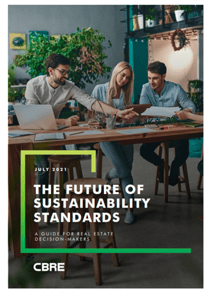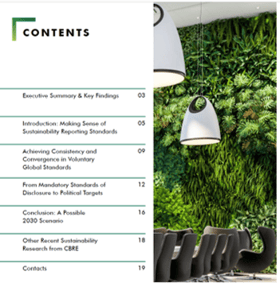Which important sustainability standards and abbreviations do you need to keep track of as input for your decision-making in the real estate industry? In this article, our Sustainability-experts in the Nordics tell you about some of the possibilities for your sustainability work and how you can get started.
Since the demands are increasing for companies to contribute to social and environmental goals, the measurement and reporting of their contribution have become more intense.
There is a wide range of global sustainability reporting standards to assist in mapping the risks and climate impact. Standards may be voluntary or mandatory to apply. The large selection of standards can make it difficult to choose and compare company and investment opportunities. Thus, developments globally and within the EU are moving towards more homogenized and comparable reporting standards, which are becoming mandatory.
- Which standards will be dominant in the future and how can we prepare for future requirements?

Our British colleagues give our recommendations in an in-depth report on the future of sustainability standards in the UK, Europe, and globally.
This article summarizes the main updates that will be relevant for the Nordics.
Download the report:
The Future of Sustainability Standards
A wide selection of standards in the market gives you multiple options but also the challenge to compare and choose
Today there are several types of standards and frameworks to determine if and how sustainable a company or an investment is. Abbreviations such as TCFD, GRI, IFRS, NFRD, GRESB are frequently used in the industry. Although companies have the option to choose how to report, the information can be difficult to compare. This leads to uncertainty about which companies and financial activities are sustainable.
Compare apples with apples
In order to invest in sustainable conversions and contribute to the Paris Agreement and climate neutrality by 2050, we need equivalent comparisons. We also need clear and consistent information. A great challenge that the EU, global and international stakeholders now are trying to handle.
New standards and framework
To equalize companies' sustainability work, risk assessment, and reporting framework, several initiatives are now underway within the EU and globally, such as
I. The EU Taxonomy
II. Reformation of the EU NFRD to ”CSRD” - Corporate Sustainability Reporting Directive
III. A global sustainability reporting standard
I. The EU Taxonomy
The EU Taxonomy aims to categorize a very wide range of economic activities, including real estate development and trading, as either contributing significantly to environmental sustainability or not.
The taxonomy will guide investors in the transition to a green economy. An economic activity qualifies as environmentally sustainable if it ‘contributes substantially to one or more environmental objectives’ and also ‘does not significantly harm any of those objectives.’
The objectives are:
- climate change mitigation;
- climate change adaptation;
- the sustainable use and protection of water and marine resources;
- the transition to a circular economy;
- pollution prevention and control; and
- the protection and restoration of biodiversity and ecosystems.
The taxonomy is currently being interpreted, translated, and adapted nationally. Some reporting will be required as early as next year.
II. Reformation of the EU NFRD to ”CSRD”
In parallel as the taxonomy develops, the EU is updating the Non-Financial Reporting Directive (NFRD). The proposal includes a name change to the "Corporate Sustainability Reporting Directive" (CSRD). It is estimated that five times more companies will be covered by the new directive. CSRD will be finalized 2023, with mandatory reporting 2024.
III. A global sustainability reporting standard
A global standard for sustainability reporting is being developed and compiled by IFRS (International Financial Reporting Standards). The proposal will be presented at the UN climate conference in November and will hopefully be approved for use in 2022. The objective is that the global standard is based on leading frameworks and forms a baseline for the upcoming CSRD.
Convergence and simplification
CBRE estimates that the number of standards will decrease, while coherence will increase. Some national adaptations will probably be needed to match the challenges of each country to avoid favoring the wrong activities and investments. This has especially been highlighted in the debate during the development of the EU Taxonomy.
Read the English report for a more detailed explication and analysis. Spoiler: TCFD (Task Force on Climate-related Financial Disclosures) is expected to be dominant.
TCFD is the Winner
Exactly how the various standards and frameworks are expected to relate to each other remains to be seen, but it is clear that the climate standard that is developed globally and in the EU is based on the so-called TCFD recommendations. Leading organizations such as GRI, SASB, and CDP support this as a way to reduce the range of different standards. TCFD provides good guidance to companies in terms of governance, strategy, and goals for their sustainability work. Even though the recommendations are voluntary, they are applied in approximately 1,600 companies globally, where the Nordics account for about ten percent.
Start reporting now
There is no reason to wait for future legal requirements. Preparations, adaptation, and development of the sustainability work and reporting can be done today. An appropriate first step is to present climate and environmental information in line with the TCFD recommendations. As far as taxonomy is concerned, it is time to identify how it affects you and the expectations of stakeholders.
Do you have questions or would like to book a meeting to discuss the standards? Please contact Emma Oterwik in Norway, Niklas Wiik in Finland, Linda Kjällén in Sweden, and Dragana Marina in Denmark. All of our experts work in the Nordic Sustainability Team.
 Download the report:
Download the report:
The Future of Sustainability Standards

